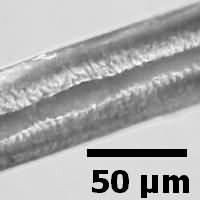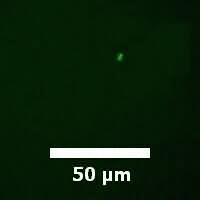 
A human hair (left, brightfield) an a piece of skin (right,
ultraviolet light) at a frame size of 100 µm x 100 µm
|
Now we are looking at an area of 1/10 000 square centimeter. At this magnification (about 500-fold) one can detect bacteria. However, one would expect only a single bacterium on this small area.
Furthermore, normally bacteria hardly differ from the background or a dust particle. Therefore, a fluorescence dye (SybrGreen) was applied in this case. The dye penetrates the cell and lets the nucleic acids emit green light under UV radiation. Thus, one can be quite sure that this is a bacterium.
|
 Bacteria on our skin
Bacteria on our skin
 Bacteria on our skin
Bacteria on our skin